The Edict of Nantes
Five Essays and A New Translation
About the Book
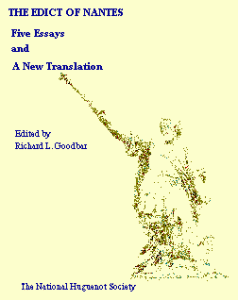 The Edict of Nantes, formally signed by Henri IV on April 13, 1598, was one of the most far- reaching, significant acts of religious tolerance in history. Ending the French “Wars of Religion”, it gave hope and varying degrees of protection to the Huguenots. Yet that document – far from being perfect – had many weaknesses. Every concession to the Huguenot “heretics” was viewed by Catholics as threatening their faith and majority status in the population, and every concession to the Catholics was interpreted as another attempt to eradicate the Huguenots in France. Throughout the negotiations Henri IV attempted to appease both Catholics and Huguenots, while keeping an eye on the pope, Spain, England, and other European powers.
The Edict of Nantes, formally signed by Henri IV on April 13, 1598, was one of the most far- reaching, significant acts of religious tolerance in history. Ending the French “Wars of Religion”, it gave hope and varying degrees of protection to the Huguenots. Yet that document – far from being perfect – had many weaknesses. Every concession to the Huguenot “heretics” was viewed by Catholics as threatening their faith and majority status in the population, and every concession to the Catholics was interpreted as another attempt to eradicate the Huguenots in France. Throughout the negotiations Henri IV attempted to appease both Catholics and Huguenots, while keeping an eye on the pope, Spain, England, and other European powers.
Five Essays and A New Translation, published by The National Huguenot Society and edited by Richard L. Goodbar, Chairman of the Committee on Publications, provides new and unique insights into the Edict’s most complex provisions. This book features articles written by five internationally renowned historians and scholars specializing in French history. Based upon study of the original source materials, these authors seek to examine and explain the Edict within the volatile political, military, and religious climate which existed at the time.
In addition, this publication contains a new translation of the Edict of Nantes, including its secret articles and brevets, which was undertaken exclusively for this book. This translation by Dr. Jotham Parsons is, by itself, over 28 pages in length, and well worth the price of the book.
This publication is a 8″x10″ softcover book containing 84 pages and 7 illustrations. It is available only through The National Huguenot Society. Price: $20.00 postpaid.
About the AuthorsBarbara B. Diefendorf, professor of history at Boston University, has written many articles on French history which have been published in scholarly journals. Her two most recent books are Beneath the Cross: Catholics and Huguenots in Sixteenth-Century Paris, and Paris City Councillors in the Sixteenth Century: The Politics of Patrimony. She has also edited with Carla Hesse Culture and Identity in Early Modern Europe (1500-1800). During the fall 1997 term she was a member of the School of Historical Studies at the Institute of Advanced Study in Princeton, New Jersey.
Mack P. Holt, an associate professor of history at George Mason University, won The National Huguenot Society book prize in 1987 for his work entitled The Duke of Anjou and Politique Struggle During the Wars of Religion. In addition to authoring numerous articles, he has written The French Wars of Religion, 1562-1629, and edited Society and Institutions in Early Modern France. He is editor of a multi-authored text for students, The Short Oxford History of France, 1500-1650, which was published in 1999.Elizabeth Labrousse, philosopher and historian, is doyenne of French Protestant studies. After a career of research at the Centre National de Recherches Scientifiques (her major books are on Pierre Bayle’s thought), she has continued to study and reflect on the relations between Protestantism and French cultural, social, and political history.
Jotham Parsons, who earned his Ph.D. in 1997 from The Johns Hopkins University, is visiting assistant professor of history at the University of Delaware. Gallicanism and its context in legal and religious culture in Paris around 1600 has been his major research interest.
J. H. M. Salmon, now retired, has been professor of history at the University of New South Wales, professor of history and dean of humanities at Waikato University, and the Marjorie Walter Goodhart professor of history at Bryn Mawr College. His many writings include: (1) The French Wars in English Political Thought; (2) Cardinal de Retz: The Anatomy of a Conspirator; (3) Society in Crisis: France in the Sixteenth Century; (4) Renaissance and Revolt: Essays in the Intellectual and Social History of Early Modern France; and (5) numerous articles on a wide range of subjects.
Michael Wolfe, associate professor of history and head of the Division of Arts and Humanities at Pennsylvania State University at Altoona, has written The Conversion of Henry IV: Politics, Power, and Religious Belief in Early Modern France, edited Changing Identities in Early Modern France, and co-edited books relating to the European medieval period. He is also the author of many articles and essays, a translator of books and articles from French into English, and a prolific reviewer of works that primarily concern French history.
Excerpts From Included Essays
For the next four years, Henri IV doggedly deferred any definitive resolution of this quandary (conversion to Catholicism) for fear it might wreck the precarious coalition of Huguenots and Catholics who fought for him. . . . Therefore, as a Leaguer Estates General met in Paris in the spring of 1593 to contemplate the election of a new king, Henri IV finally realized that the moment of decision was at hand. On June 25th, after several months of careful instruction, Henri IV formally abjured Calvinism and reconverted to Catholicism at the abbey church of Saint Denis. While this momentous act in time allowed the Catholic Leaguers to accept him as their king, it caused great distress in the Huguenot community at large.
Michael Wolfe, “The Edict of Nantes: French Origins and European Impacts”
The clause in the edict allowing Protestants access to offices proved a particular sticking point, especially when it came to the mandatory appointment of Huguenot magistrates to the chambres mi-parties. The edict originally intended that ten Catholic and six Protestant judges should sit in the proposed chamber of the Parlement of Paris to adjudicate disputes involving both faiths. In face of criticism, the king (Henri IV) was obliged to reduce Huguenot representation to one. In the provincial parlements, however, the proportion remained closer to parity.
J. H. M. Salmon, “Opposition to the Edict of Nantes”
Although the parlements did eventually give into the royal will, it was a very grudging acceptance. The Parlement of Paris registered it (the Edict of Nantes) on 25 February 1599, just two weeks after its delegation’s visit to the Louvre. The provincial parlements were more recalcitrant, raising further objections and delaying for as long as possible. The edict was not registered in the Parlement of Grenoble until September 1599, while the Parlements of Dijon and Toulouse held out until January 1600 and the Parlements of Aix and Rennes until August 1600. Finally, the Parlement of Rouen steadfastly refused to register the Edict of Nantes in its entirety until August 1609, a full ten years after it was first promulgated. Like many Catholics, all the parlements feared that the temporary religious co-existance afforded the Huguenots by the peace would allow them to regroup and eventually to advance the Calvinist cause anew, especially since the edict allowed them to remain armed and in control of so many fortified towns.
Mack P. Holt, “The Memory of All Things Past: Provisions of the Edict of Nantes (1598)”
The terms of the Edict of Nantes could quite easily become realities because, while still vexing to the two ardent but marginal camps with their exclusive beliefs, it benefited in the long run the two rival religious confessions by bringing security for the majority of the population. Indeed, the edict brought about the return of all property to the Roman Catholic Church that had been confiscated by the Protestants, especially in the south, and it re-established all over the kingdom the dense network of Catholic parishes. In addition, all the king’s subjects, including the Protestants, were required to pay the traditional parish tithe, or dîmes, to the Catholic clergy. In turn, the establishment of Reformed Church “exercises” in temples (because the term church was reserved for the Catholic majority) could not be erected just anywhere, but were restricted to about a thousand towns, villages, and castles.
Elizabeth Labrousse, “Reflections on the Edict of Nantes”
I want to conclude, however, in stressing the magnitude of this achievement (the Edict of Nantes). When we recognize the power of the forces still working against a religious settlement, we can better understand that we must celebrate even the limited and grudging toleration mandated by the Edict of Nantes. It allowed the Huguenot communities a necessary respite, a period of time whose very uncertainty encouraged them to nurture deeply those religious values and traditions that permitted the Reformed Church’s survival through the years under the cross.
Barbara B. Diefendorf, “The failure of Peace Before Nantes”
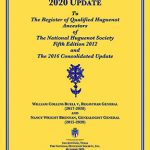 2020 UPDATE to The 2012 Register of Approved Huguenot Ancestors, Fifth Ed. 2012 and The 2016 Consolidated Update (2020). The 70-page 2020 UPDATE is a supplement to The National Huguenot Society’s previously published Register of Qualified Huguenot Ancestors of The National Huguenot Society Fifth Edition 2012 and the Consolidated Update 2016. 70 pages, soft cover, indexed. Price: $22.00 postpaid for members, $28.00 postpaid for non-members. Read more…
2020 UPDATE to The 2012 Register of Approved Huguenot Ancestors, Fifth Ed. 2012 and The 2016 Consolidated Update (2020). The 70-page 2020 UPDATE is a supplement to The National Huguenot Society’s previously published Register of Qualified Huguenot Ancestors of The National Huguenot Society Fifth Edition 2012 and the Consolidated Update 2016. 70 pages, soft cover, indexed. Price: $22.00 postpaid for members, $28.00 postpaid for non-members. Read more…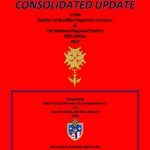 2016 Consolidated Update to Register of Qualified Huguenot Ancestors of The National Huguenot Society Fifth Edition, 2012. The 2016 Consolidated Update is a supplement to The National Huguenot Society’s previously published Register of Qualified Huguenot Ancestors of the National Huguenot Society, Fifth Edition 2012. This consolidated update – meant to be used for genealogical research in conjunction with the 2012 publication – contains new and corrected lineage information received in 2013, 2014, and 2015 that is not included in the base publication. 56 pages, soft cover, indexed. Price: $20.00 postpaid for members, and $23 .00 postpaid for non-members. Read more…
2016 Consolidated Update to Register of Qualified Huguenot Ancestors of The National Huguenot Society Fifth Edition, 2012. The 2016 Consolidated Update is a supplement to The National Huguenot Society’s previously published Register of Qualified Huguenot Ancestors of the National Huguenot Society, Fifth Edition 2012. This consolidated update – meant to be used for genealogical research in conjunction with the 2012 publication – contains new and corrected lineage information received in 2013, 2014, and 2015 that is not included in the base publication. 56 pages, soft cover, indexed. Price: $20.00 postpaid for members, and $23 .00 postpaid for non-members. Read more…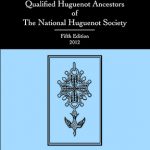 Register of Qualified Huguenot Ancestors of The National Huguenot Society, Fifth Edition 2012. Compiled by Jeannine Sheldon Kallal. The National Huguenot Society, Inc., 2012. Identifies more than 600 Huguenot ancestors with brief biographical sketches and provides at least two generations of each ancestors’ descendants. By listing the proven ancestors whose descendants have joined The National Huguenot Society over the years the Register of Qualified Huguenot Ancestors of The National Huguenot Society, Fifth Edition 2012 is more than a mere reference book; it is potentially the go-to source of Huguenot genealogical data available today in America. 573 pages, soft cover, indexed. Price: $63.00 postpaid for members, $73.00 postpaid for non-members. Read more…
Register of Qualified Huguenot Ancestors of The National Huguenot Society, Fifth Edition 2012. Compiled by Jeannine Sheldon Kallal. The National Huguenot Society, Inc., 2012. Identifies more than 600 Huguenot ancestors with brief biographical sketches and provides at least two generations of each ancestors’ descendants. By listing the proven ancestors whose descendants have joined The National Huguenot Society over the years the Register of Qualified Huguenot Ancestors of The National Huguenot Society, Fifth Edition 2012 is more than a mere reference book; it is potentially the go-to source of Huguenot genealogical data available today in America. 573 pages, soft cover, indexed. Price: $63.00 postpaid for members, $73.00 postpaid for non-members. Read more…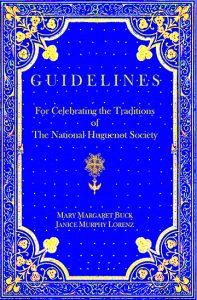 GUIDELINES For Celebrating the Traditions of The National Huguenot Society. By Mary Margaret Buck and Janice Murphy Lorenz (2019). This 56-page handbook is useful for conducting Huguenot meetings and social events. It describes some basic Huguenot traditions and ceremonies honoring our French Protestant ancestors for the sacrifices they made for our country and for the right to exercise freedom of conscience in America. $16.00 postpaid.
GUIDELINES For Celebrating the Traditions of The National Huguenot Society. By Mary Margaret Buck and Janice Murphy Lorenz (2019). This 56-page handbook is useful for conducting Huguenot meetings and social events. It describes some basic Huguenot traditions and ceremonies honoring our French Protestant ancestors for the sacrifices they made for our country and for the right to exercise freedom of conscience in America. $16.00 postpaid.


 The Edict of Nantes, formally signed by Henri IV on April 13, 1598, was one of the most far- reaching, significant acts of religious tolerance in history. Ending the
The Edict of Nantes, formally signed by Henri IV on April 13, 1598, was one of the most far- reaching, significant acts of religious tolerance in history. Ending the 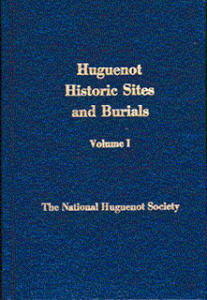 The publication of Huguenot Historic Sites and Burials has been a dream of the 1999-2001 President General and officers of The National Huguenot Society. That dream has now become a reality.
The publication of Huguenot Historic Sites and Burials has been a dream of the 1999-2001 President General and officers of The National Huguenot Society. That dream has now become a reality.